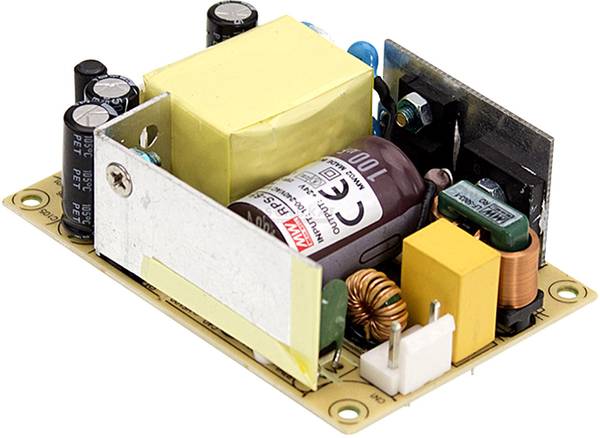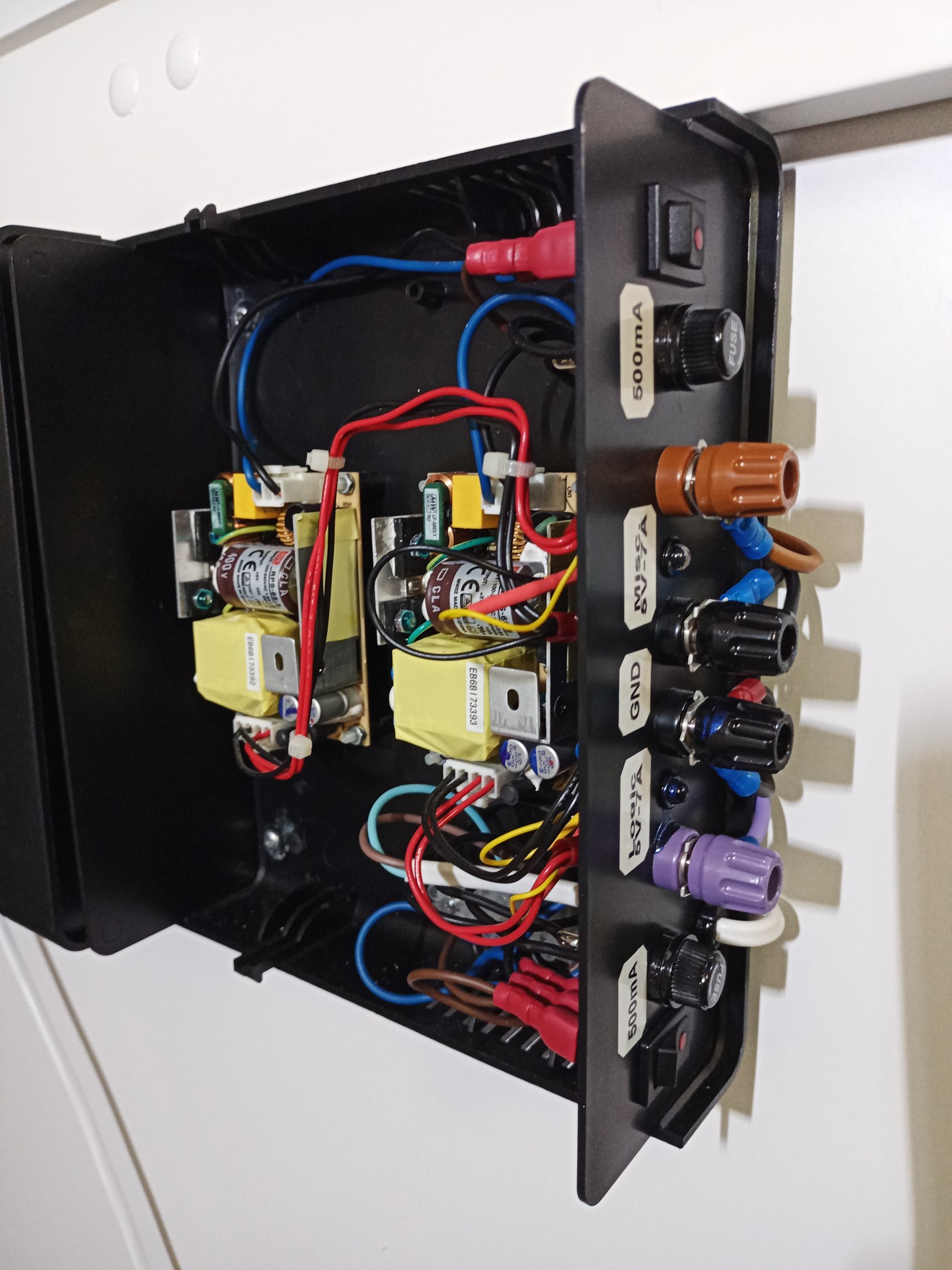Logic 5V and miscellaneous 5V power supply
Application switch mode power supply
This power supply provides two independent power outputs, one for logic digital circuits and one for track circuits and miscellaneous loads like illumination devices. The power supply for the track circuits and miscellaneous components is a independent unit to avoid the wrong operation of track circuits. At the other hand the power supply for logic digital components is a independent unit to avoid the faulty operation of logic digital components due to noise.
Two AC/DC switch mode power supply modules are used. They have a power rating of 7A. This is higher than required but avoids reformation of the plastic enclosure due to overheating. It is the same enclosure used for the above 'Dual plus and minus 15V power supply'.
Description components and wiring
The used switch mode power supply is a Mean Well RPS-65-5 5, see image below. The price of each unit was around €17.00 in 2020.

The logic 5V and miscellaneous 5V power supply circuits have each its own mains power switch S1 resp. S2 and fuse F1 resp. F2. These and the neutral are connected to the hot side of the switch mode power supply X1 resp. X2 by a female crimp plug J1 resp. J2, see photo below.

The 5VDC cold side of the switch mode power supply for logic circuits is connected to a violet pole terminal J5 and the one for miscellaneous devices to a brown pole terminal J6. The GND of each switch mode power supply is individually connected to the black pole terminals J7 resp. J8. All these 5VDC and GND wires are connected to the switch mode power supplies with 4 pole female crimp plug J3 resp. J4. The current rating for the DC connectors and wires is 22 A.
The 5VDC for logic circuits is connected via a current limiting resistor R1 to a blue LED D1. The 5VDC for miscellaneous devices is connected via a current limiting resistor R2 to a green LED D2.
Part list with components are stated below.
| ID | Component | Properties | Qty |
|---|---|---|---|
| X1, X2 | AC/DC PSU module (open frame) Mean Well RPS-65-5 5, ripple(PP) 80mV, efficiency 84% | 5VDC, 11A | 2pcs |
| D1 | LED wired Blue Circular 5 mm, 1150mcd, 20° | 20 mA, 3.5V | 1pcs |
| D2 | LED wired Green Circular 5 mm, 1000mcd, 20° | 20 mA, 2.1V | 1pcs |
| F1, F2 | TRU COMPONENTS TC-R3-12 Fuse holder Suitable for Micro fuse 5 x 20mm, 10A, 250V AC | D=15mm∅ | 2pcs |
| F1, F2 | Püschel FST0,315B Micro fuse (Ø x L) 5 x 20mm, time delay | 0.315A, 250V | 2pcs |
| R1, R2 | Carbon film resistor 270Ω Axial lead 0207, 0.25W, 5% | Type 0207 | 2pcs |
| S1, S2 | SCI Toggle switch R13-66B2-02 (250V/AC 150KR) 250VAC, 6A, 1 x Off/On latch | L=19.4mm, W=13mm | 2pcs |
| W1 | GAO 6777 Current cable white 1.50m | Max. 2.5A | 1pcs |
| W2 | TRU COMPONENTS TC-SR-F21203 Strain relief Terminal Ø (max.) 5.3mm black |
|
2pcs |
| J1, J2 | JST VHR-3N VHR-3N Casing Series VH Number of pins: 3 Nominal current: 10A | AWG #22 to #16 | 2pcs |
| J3, J4 | JST VHR-4N VHR-4N Casing Series VH Number of pins: 4 Nominal current: 10A |
AWG #22 to #16 |
2pcs |
| J1, J2, J3, J4 | JST BVH-21T-P1.1 BVH-21T-P1.1 Crimp Contact For Series VH Nominal current: 10A | AWG #22 to #16 | 12pcs |
| J5 |
Hirschmann 35A SKS pole terminal PKI 10 A Stift-Ø: 4mm violet |
M4, 35A, ~7∅ |
1pcs |
| J6 | Hirschmann 35A SKS pole terminal PKI 10 A Stift-Ø: 4mm brown | M4, 35A | 1pcs |
| J7, J8 | Hirschmann 35A SKS pole terminal PKI 10 A Stift-Ø: 4mm black |
M4, 35A |
2pcs |
| E1 | Universal enclosure 180 x 205 x 70mm Polystyrene (EPS) black |
|
1pcs |
| E2 | TOOLCRAFT 839971 Countersunk screws M4 - 25 mm Phillips DIN 965 plastic, polyamide 10 pc(s) | Bag of 10 | 1pcs |
| E3 |
Spacer w/o thread M4 Polystyrene Distance 15mm |
|
8pcs |


